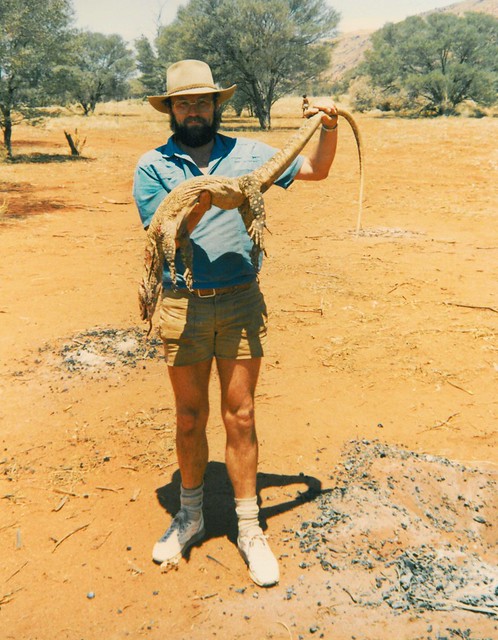The family groups of Angatja, Upukula and Narari are allocated approximately 100 km from each other and the Anangu are all very closely related. Time is not at all important and they still rely more on their traditional time schedule (dawn, mid-morning, midday, afternoon, dusk) rather than on our hours and minutes. So, it was not at all strange that when we arrived in Angatja, 450 km south west of Alice Springs that there was nobody to welcome us.
Angatja has two houses, one generator and a water bore but the Anangu are still basically living outside. Later we found out that they had expected us two days later but no worries, in the afternoon everybody came home, one after the other and black and white prepared their camps in the dry riverbed of the Angatja river.

Such a spot is ideal, sandy, flat, no prickly plants and a lot shade given by the Red River Gums. Like the Anangu, the white people were split into small groups (five people) to blend in with the Anangu camp sites. Every camp had its own campfire and prepared its own food, like a little family. We slept in swags, the Anangu slept under blankets on a large pieces of foam.
All this was organised at an easy pace, no hurry. Everything comes as it comes. But even in such a relaxed atmosphere we ‘whites’ were well organised with coffees, teas, lunches and dinners, and we had to organise ourselves in such a way that each one of us had their own tasks. Just when we e.g. had all things organised for lunch, it could well be that the Anangu informed us that the hunting party was ready to go. Gone organisation!
Ilyatjari, Nganyinytja’s husband laughed his head off especially if at such an occasion the white men were doing women’s work such as collecting water, cooking, or washing the dishes, he really thought we were fools. Once in the car ready for the hunting party he would precisely tell us what he thought of that.
This did not mean that he did not respect women’s work or that he thought such work is less important. In the Anangu society, each gender has their specific duties. This all took place with harmony without commands or pressure.
In the first few days the white women in our group were not at all at ease with this division between men and women. But it was remarkable to observe how these attitudes changed once they started to get the feeling of this society.
A similar incident occurred the other way around when a white man wanted to join a women’s hunting party. White and black women repeatedly told him to go away indicating that he was trespassing the traditional rules.
There were three generations present at Angatja:
- Grandparents such as Nganyinta and Ilyatjari.
- Parents such as Sammy and Celia (see further in the story)
- Children such as Michael and Rosanna
The total population of Angatja varies between 25 and 40, depending on who is “in” today. The nomadic nature is still very much present. Angatja like the other new communities under the Land Rights Act, however, are becoming more and more permanent.
The grandparents are looking after the traditional education of the children. Sometimes the children go to school in Amata, 150 km away, but Nganyinta would like to have an Aboriginal teacher visiting Angatja.
As described before, men can have more wives but except for Sammy, the men in Angatja only had one wife. It is also interesting to state here that Nganyinta, when she married Ilyatjari, broke with the tradition by not marrying the man that was given to her in betrothal by her family. Nganyinta persuaded Ilyatjari to come to her land, this was not totally uncommon, but the general rule was that women joined the tribe or group of the men.
Most of the food for Angatja nowadays comes from Amata. But (fortunately) because of the distance, this food – flour, Weetbix, and other non-perishables – must be complemented with fresh food such as kangaroo, goanna, bush foods, etc. In places such as Amata where there is a shop, the Anangu stop hunting and gathering bush foods and sometimes live only on flour products. The Australian Government is very much stimulating the Anangu to have a more balanced diet. Diabetics is one of the major health problems facing modern Aboriginal life.

Our (white) enthusiasm for traditional hunting and bush food will certainly contribute to keep the Anangu interested in these traditions.
At the end of the first day, when black and white joined around the campfire, the first contacts were established. Tjukurrpa stories were told and they sung and danced for us. Slowly the two cultures melted together. We were fully accepted, and we were welcome in all the camps, we could talk to everybody, make pictures, etc.